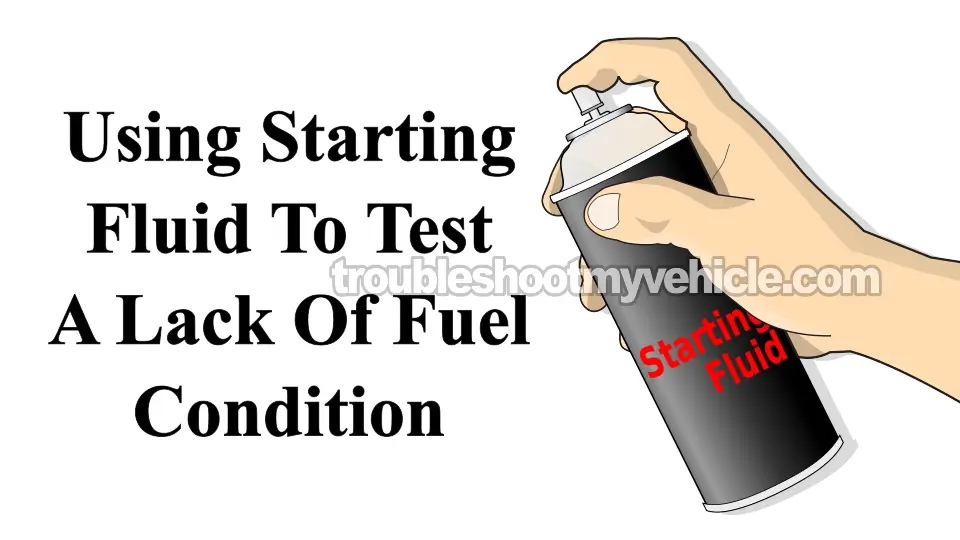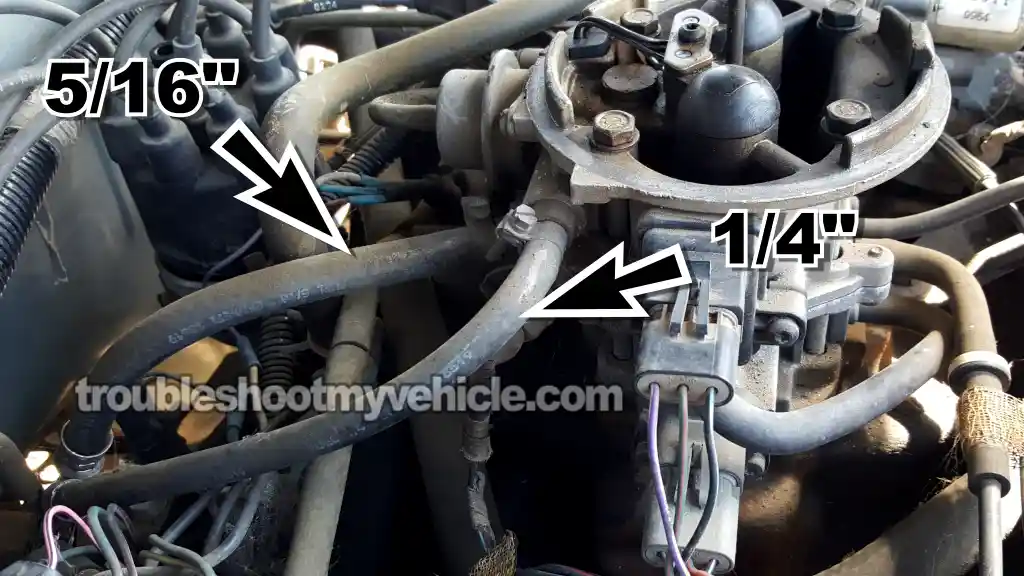
You can check the fuel pump on your 1989-1991 5.2L or 5.9L V8 Dodge Ram pickup (with throttle body injection —TBI) using a fuel pressure gauge.
In this tutorial, I'll walk you through the process step by step. Once you've done the test, you'll know for sure if the fuel pump is doing its job or if it's dead.
I'm also gonna go over how to use starting fluid to help you figure out whether your engine isn't firing up because it's got a fuel delivery problem.
Contents of this tutorial:
APPLIES TO: This tutorial applies to the following Dodge Ram pickups:
- 5.2L, 5.9L V8 Dodge Ram 100 Pickup: 1989, 1990, 1991.
- 5.2L, 5.9L V8 Dodge Ram 150 Pickup: 1989, 1990, 1991.
- 5.2L, 5.9L V8 Dodge Ram 250 Pickup: 1989, 1990, 1991.
WIRING DIAGRAMS:
- Fuel Pump Circuit Wiring Diagram (1989 5.2L, 5.9L V8 Dodge Ram Pickup).
- Fuel Pump Circuit Wiring Diagram (1990-1991 5.2L, 5.9L V8 Dodge Ram Pickup).
ENGINE NO-START TESTS:
1992-2003 FUEL PRESSURE TEST:
Symptoms Of A Bad Fuel Pump
Fuel pumps usually fail in one of two ways:
- Total failure: The pump stops working altogether and no fuel reaches the injectors. The engine cranks, but it never fires up.
- Weak output: The pump still runs —it sends just enough fuel to get the engine to start, but not enough to keep it going once you're driving or putting it under load.
If the pump's struggling but not completely toast, you might see one or more of these issues:
- Rough idle: The engine runs rough while idling (especially with the transmission in Drive).
- Hard start: You have to crank it for what feels like forever before it finally starts.
- Lack of power: It really shows when you drop it into Drive and try to accelerate —the truck just doesn't respond like it should.
- Backfiring: You'll hear popping noises from the intake when you hit the gas —a sign the engine's running lean and the fuel pump is struggling to keep up.
- Lean condition: Too little fuel throws off the air/fuel ratio and can set off fuel system or oxygen sensor trouble codes.
Whether your truck won't start at all or just runs bad, a quick check with a fuel pressure gauge can show if the fuel pump's to blame.
What does "lean" mean? Your engine needs the right balance of air and fuel to run right. The fuel system adds fuel based on how much air is flowing in. If the pump isn't keeping up and fuel's too low for the amount of air, you've got a "lean" mix —not enough fuel for proper combustion.
When the opposite happens and too much fuel gets added for the amount of air, that's called a "rich" air/fuel mixture.
Fuel Pressure Specifications
| 1989-1991 | |
|---|---|
| 5.2L, 5.9L V8 | 14.5 PSI (Throttle Body Injection -TBI- System) |
Where To Buy A Fuel Pressure Test Gauge
A fuel pressure test gauge is a must-have for any serious DIY mechanic and thankfully, you can buy them just about anywhere. If you don't already own one, it's definitely worth adding to your toolbox.
Here are a few good kits that will work with your TBI fuel injected V8 Dodge Ram Pickup:
Disclosure: As an Amazon Associate, I earn from qualifying purchases. If my tutorials help you, using these links is an easy way to support the site at no extra cost to you. Thank you!
TEST 1: Checking Fuel Pressure With A Fuel Pressure Gauge
Your throttle body has two rubber fuel hoses connected to it. The larger one —the 5/16" hose— brings in fuel under pressure. The smaller one —1/4"— sends unused fuel back through the return line (see image 2 of 2 in the image viewer above).
To test fuel pressure, we're gonna slip a pressure test adapter between the 5/16" inlet hose and the throttle body's metal inlet port (check the illustration above to see what that looks like).
You'll find that metal port at the lower rear section of the throttle body —that's where the 5/16" hose connects. The smaller top-side hose plugs into the return line.
If you don't have a test kit that includes the right adapter, check out my recommended tools here: Where To Buy A Fuel Pressure Test Gauge.
Alright, here's what we're gonna do:
- 1
Take off the air cleaner assembly from the throttle body.
- 2
Unplug the vacuum hose from the fuel pressure regulator.
- 3
Disable the ignition system. We don't want the ignition system to generate spark.
NOTE: Disconnect one of the two wires at the ignition coil. Do not disconnect the distributor's 3-wire connector (it has to remain connected). - 4
Disconnect the electrical connector for the fuel injectors. No fuel should spray while you run the pressure test.
- 5
Slide a shop rag under the fuel inlet hose.
It'll catch any gas that drips out in the next step. - 6
Pull the 5/16" fuel inlet hose off the throttle body's port.
NOTE: You've got two hoses there —5/16" and 1/4". Go for the bigger one, that's the fuel supply line. - 7
Connect the adapter hose to the inlet port, then attach the pressure gauge adapter to it.
- 8
Now take that 5/16" hose you removed and plug it into the other end of the fuel pressure gauge adapter.
- 9
With everything connected, have your helper turn the key on and off a few times but don't crank the engine yet.
Look over the adapter and hoses for fuel leaks. If you spot one, tighten the clamps until the leak stops. - 10
Crank the engine and keep your eyes on the pressure gauge.
NOTE: The engine shouldn't start (since both the fuel injectors and ignition system should be disabled). - 11
You should see about 14.5 PSI on the gauge.
Let's go over your results:
CASE 1: Fuel pressure reads 0 PSI. That means no fuel's making it to the injectors and that's why your engine won't start.
Almost every time, this means the fuel pump's dead and needs replacing. That said, before calling it done, make sure the pump is getting 10 to 12 Volts DC while you're cranking the engine. If there's no power, the problem isn't the pump —it's the wiring or relay.
CASE 2: Gauge shows pressure, but it's below spec. That means the pump's weak. It's not keeping up. Time to swap it out.
CASE 3: Pressure is right at 14.5 PSI. Your pump's working just fine.
If your Dodge Ram won't start but you're getting good fuel pressure, then the pump's not the issue. Fuel's reaching the injectors, so you'll need to keep troubleshooting since something else is stopping that engine from firing up.
TEST 2: Using Starting Fluid To Confirm Lack Of Fuel

If you're trying to figure out whether your truck won't start because it's not getting fuel, a quick trick is to use starting fluid and see if the engine catches.
The test's simple: spray starting fluid into the throttle body, then crank the engine and see if it runs, even if only for a moment.
If fuel delivery is the problem, the engine will fire up and run briefly —just long enough to burn off the starting fluid you sprayed in.
This isn't the most exact way to diagnose a bad fuel pump, but it's a solid first step when you're narrowing down the cause of an engine no-start issue.
NOTE: For this test to give you an accurate result, all spark plug wires need to be firing spark. Haven't checked for spark yet? Do that first.
IMPORTANT: This test is quick and easy, but don't skip this safety step: once you spray the fluid, put the air cleaner assembly back over the throttle body before cranking. You don't need to bolt it down —just place it on top. This helps prevent any backfire from sending flames over and onto the engine.
Let's run the test:
- 1
Pop the top off the air cleaner assembly.
No need to pull the whole thing —just remove the cover so you can reach the throttle plate. - 2
Hold the throttle open and spray some starting fluid down into the throttle body.
- 3
Once you've sprayed it, set the top cover back on the air cleaner.
You're not clamping it —just resting it in place. - 4
Crank the engine with the cover sitting back on the assembly.
- 5
One of two outcomes is gonna happen:
1.) The engine starts and runs for a few seconds, then stalls.
2.) The engine cranks, but never catches.
So, what does that result tell us?
CASE 1: Engine fired up, ran for a bit, then quit. That points straight to a fuel delivery problem —most likely the pump's not sending fuel.
Your next step is to confirm it with a pressure gauge. Head here: TEST 2: Checking Fuel Pressure With A Fuel Pressure Gauge.
CASE 2: Engine didn't start at all. That suggests the no-start isn't being caused by lack of fuel.
Still, like I said earlier, this method isn't super precise. Even if it doesn't start, it's smart to test fuel pressure properly just to be sure. Go to: TEST 2: Checking Fuel Pressure With A Fuel Pressure Gauge.
More 5.2L, 5.9L V8 Dodge Ram Pickup Tutorials
I've written quite a few 5.2L, 5.9L V8 Dodge Ram pickup 'how to test' tutorials. You can find them in this index:
Here's a small sample of the articles/tutorials you'll find in the index:
- How To Test The TPS (1989-1990 5.2L, 5.9L V8 Dodge Ram Pickup).
- How To Test The Camshaft Position Sensor (1992-1995 5.2L, 5.9L V8 Dodge Ram Pickup).
- How To Test Engine Compression (1989-2003 5.2L, 5.9L V8 Dodge Ram Pickup).
- Troubleshooting A Blown Head Gasket (1989-2003 5.2L, 5.9L V8 Dodge Ram Pickup).

If this info saved the day, buy me a beer!






